|
 |
 |
| Small-spotted adult, Shasta County |
Adult, Shasta County
© Zach Lim |
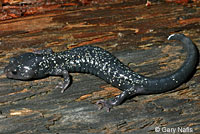 |
 |
 |
 |
| Small-spotted adult, Shasta County |
 |
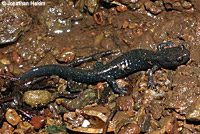 |
 |
 |
| Juvenile, Shasta County |
Juvenile, Shasta County
© Jonathan Hakim |
Adult, Shasta County
© Jonathan Hakim |
Adult, Shasta County
© Jonathan Hakim |
 |
 |
 |
 |
Adult, Shasta County
© Jonathan Hakim |
Adult, Shasta County
© Jonathan Hakim |
Adult and juvenile, Shasta County
© Jonathan Hakim |
Juvenile, Shasta County
© Mark Gary |
 |
 |
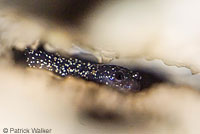 |
 |
Adult, eastern Tehama County, just north of Red Bluff, which should represent a range extension for this species.
© Ryan Henson
|
Adult, Shasta County
© Spencer Williams
|
Two salamanders photographed in cracks inside a Shasta County cave about
8 feet above the cave floor. © Patrick Walker |
| |
|
| Habitat |
 |
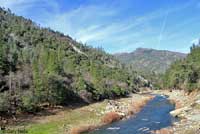 |
 |
|
Habitat, Shasta County
|
Habitat, Shasta County |
Habitat, Shasta County |
|
 |
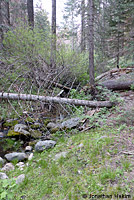 |
|
|
Habitat, Shasta County
© Jonathan Hakim |
Habitat, Shasta County
© Jonathan Hakim |
|
|
| |
|
|
| Identification Help |
 |
|
|
|
Black Salamanders have toes with rounded tips.
Compare with Aneides vagrans, Wandering Salamander, and
Aneides ferreus, Clouded Salamander,
which have toes with squared-off tips.
|
|
|
|
| |
| Short Videos of Similar Species |
|
|
 |
|
| A Black salamander is discovered under a rock on a sunny late November afternoon in Mendocino County. Several adults and a juvenile move slowly and with amazing bursts of speed. |
Sprinting Black salamanders from southern Humboldt County.
|
A black salamander in
Mendocino County. |
|
|
|
|
|
| Description |
Most of the following description is taken from descriptions of Aneides flavipuntatus, with which this species was formerly classified. Specific details of this species may differ somewhat.
|
| Size |
Adults measure 2 - 3 3/4 inches long (5.1 - 9.5 cm) from snout to vent, and up to 5.5 inches (14 cm) total length.
|
| Appearance |
| A large robust plethodontid salamander with two nasolabial grooves and 14 - 16 well-defined costal grooves. |
| Color and Pattern |
| Adults are black with moderate to heavy white speckling on the head, body, and tail. The venter is grayish black. |
| Male/Female Differences |
| Males have a broader head than females. |
| Young |
Young are similar to adults - black with moderate to heavy white speckling.
|
| Comparison With Other Black Salamanders |
"This species is distinguished from other members of the Aneides flavipunctatus complex by its heavily speckled head, body and tail (Lynch, 1981) ... it is further distinguished from both A. klamathensis and A. niger by having an average of 16 rather than 17 trunk vertebrae."
(Reilly & Wake 2019) |
| |
| Life History and Behavior |
A member of family Plethodontidae, the Plethodontid or Lungless Salamanders.
Plethodontid salamanders do not breathe through lungs. They conduct respiration through their skin and the tissues lining their mouth. This requires them to live in damp environments on land and to move about on the ground only during times of high humidity. (Plethodontid salamanders native to California do not inhabit streams or bodies of water but they are capable of surviving for a short time if they fall into water.)
Plethodontid salamanders are also distinguished by their nasolabial grooves, which are vertical slits between the nostrils and upper lip that are lined with glands associated with chemoreception.
All Plethodontid Salamanders native to California lay eggs in moist places on land.
The young develop in the egg and hatch directly into a tiny terrestrial salamander with the same body form as an adult.
(They do not hatch in the water and begin their lives as tiny swimming larvae breathing through gills like some other types of salamanders.)
|
| Activity |
Adapted for climbing with long toes and rounded prehensile tail, but mostly terrestrial.
Adults forage for small invertebrates on the ground at night during wet weather.
May be active along streams all year at the southern part of its range, but most stay underground during dry periods. |
Territoriality
|
| Adults appear to be aggressively territorial. |
| Longevity |
| Black Salamanders have lived as long as 20 years in captivity. |
| Defense |
| When threatened, juveniles typically remain still while adults attempt to flee. Other defense tactics include defensive posturing - raising the body, lowering the head, and waving the tail, jumping, releasing noxious sticky skin secretions, and biting. |
| Diet and Feeding |
Diet consists of a variety of small invertebrates, including millipedes, ants and termites.
As salamanders grow larger, they eat fewer, but larger prey items. |
| Reproduction |
Reproduction is terrestrial.
Courtship and breeding behavior is not well known.
Breeding males have a well-developed mental gland.
|
| Eggs |
Females probably lay from 8 - 25 eggs in moist cavities below the ground in July and August.
Eggs are attached by peduncles.
Females stay with the eggs until they hatch. |
| Young |
Young develop completely in the egg and hatch fully formed.
|
| Habitat |
Occurs in mixed deciduous woodland, lowland coniferous forests, coastal grasslands.
Found under rocks near streams, in talus, under damp logs, and other objects.
|
| Geographical Range |
The known range of this species so far is only in Shasta County, in an area around Mt. Shasta but it might also occur south in Tehama and Glenn counties.
"The species is known from north central and western Shasta County, California, as well as extreme southeastern Siskiyou County in the vicinity of Castle Crags, California, but the identity of scattered specimens from the western margin of the Sacramento Valley to the south has not been determined. Aneides iecanus occurs at elevations ranging between about 300 m (near the surface of Lake Shasta) to over 1,000 m (in the Castle Crags area). Populations along the inner margins of the Coast Ranges in western Tehama and Glenn Counties ... may be assignable to Aneides iecanus, but further surveys including morphological and genetic analyses are needed." (Reilly and Wake 2019)
|
| Taxonomic Notes |
"Populations along the inner margins of the Coast Ranges in western Tehama and Glenn Counties may be assignable to A. iecanus, but further surveys including morphological and genetic analyses are needed (Reilly and Wake, 2019, PeerJ, 7: e7370)."
(Nicholson, K. E. (ed.). 2025 SSAR Scientific and Standard English Names List)
-----------------------------------------------------------------------------------------------------------------------------------------------------------------------------------------------------------------------------
Aneides flavipunctatus was split into four species in August, 2019. The subspecies Aneides flavipunctatus flavipunctatus was elevated in rank to a full species.
In a 2019 paper Reilly & Wake confirmed that Aneides flavipunctatus consists of four species:
Klamath Black Salamander - Aneides klamathensis Stebbins, 1951 & Dubois and Raffaelli, 2009
Speckled Black Salamander - Aneides flavipunctatus (Strauch 1870)
Shasta Black Salamander - Aneides iecanus (Cope 1883)
Santa Cruz Black Salamander - Aneides niger Myers & Maslin 1948
(Reilly SB, Wake DB. 2019. Taxonomic revision of black salamanders of the Aneides flavipunctatus complex (Caudata: Plethodontidae) PeerJ 7:e7370 https://doi.org/10.7717/peerj. 7370)
-----------------------------------------------------------------------------------------------------------------------------------------------------------------------------------------------------------------------------
In a 2014 paper, Reilly and Wake continue to show four species-level units of A. flavipunctatus, including the isolated population south of the San Francisco Bay, but they do not describe any new species.
(Sean B. Reilly and David B. Wake. Cryptic diversity and biogeographical patterns within the black salamander (Aneides flavipunctatus) complex.
Journal of Biogeography, 2014.)
-----------------------------------------------------------------------------------------------------------------------------------------------------------------------------------------------------------------------------
In a study published in 2007, Rissler and Apodaca determined that even though there is little morphological divergence across the species, the use of mtDNA analyses and ecological modeling indicates that there are four separate main lineages of A. flavipunctatus which eventually should be given full species status: A Southern Disjunct lineage on the San Francisco Peninsula and in the Santa Cruz Mountains; a Shasta lineage in the Mount Shasta region; a Central lineage on the north coast and north coast ranges north of San Francisco Bay; and a Northwest lineage in the northwest corner of the state including Humboldt, Del Norte, and Siskiyou Counties. There is another population within the Central Lineage which is also distinct, but they do not discuss this in detail. They recommended that the Shasta and Southern lineages be elevated to species status, but that more work is needed to determine the southern extent of the Northwest lineage. Once that has been determined, they recommend that the Northwest lineage also be elevated to species status.
(Rissler, Leslie J., and Joseph J. Apodaca. Adding More Ecology into Species Delimitation: Ecological Niche Models and Phylogeography Help Define Cryptic Species in the Black Salamander (Aneides flavipunctatus). Syst. Biol. 56(6):924–942, 2007 )
-----------------------------------------------------------------------------------------------------------------------------------------------------------------------------------------------------------------------------
|
Alternate and Previous Names
Aneides flavipunctatus flavipunctatus - Speckled Black Salamander (Stebbins & McGinnis 2012 & 2018)
Aneides flavipunctatus - Black Salamander (Stebbins 1985, 2003)
Aneides flavipunctatus flavipunctatus - Speckled Black Salamander (Stebbins 1966)
Aneides flavipunctatus flavipunctatus - Black Salamander (Stebbins 1954)
Aneides flavipunctatus - Black Salamander (Shasta Salamander) (Bishop 1943)
Autodax iecanus - Shasta Salamander - Black Salamander (Grinnell and Camp 1917)
Autodax iecanus (Cope 1886)
Aneides iecanus (Cope 1886)
Plethodon flavipunctatus (Strauch 1870)
|
| Conservation Issues (Conservation Status) |
"The most vulnerable of the four species of the Aneides flavipunctatus complex are A. niger and A. iecanus. Both have relatively small geographic ranges within which critical habitat has been heavily impacted by humans."
(Reilly and Wake 2019)
|
|
| Taxonomy |
| Family |
Plethodontidae |
Lungless Salamanders |
Gray, 1850 |
| Genus |
Aneides |
Climbing Salamanders |
Baird, 1851 |
Species
|
iecanus |
Shasta Black Salamander |
(Cope, 1883) |
|
Original Description |
Aneides iecanus - Cope, 1883
|
|
Meaning of the Scientific Name |
Aneides - Greek = lacking form or shape
from Scientific and Common Names of the Reptiles and Amphibians of North America - Explained © Ellin Beltz
iecanus - "The Species name was derived from the local Native American word "Ieka" which according to Cope refers to Mount Shasta."
(Reilly and Wake, 2019)
|
|
Related or Similar California Salamanders |
Aneides ferreus - Clouded Salamander
Aneides flavipunctatus - Speckled Black Salamander
Aneides klamathensis - Klamath Black Salamander
Aneides lugubris - Arboreal Salamander
Aneides niger - Santa Cruz Black Salamander
Aneides vagrans - Wandering Salamander
|
|
More Information and References |
California Department of Fish and Wildlife
AmphibiaWeb
Hansen, Robert W. and Shedd, Jackson D. California Amphibians and Reptiles. (Princeton Field Guides.) Princeton University Press, 2025.
Stebbins, Robert C., and McGinnis, Samuel M. Field Guide to Amphibians and Reptiles of California: Revised Edition (California Natural History Guides) University of California Press, 2012.
Stebbins, Robert C. California Amphibians and Reptiles. The University of California Press, 1972.
Flaxington, William C. Amphibians and Reptiles of California: Field Observations, Distribution, and Natural History. Fieldnotes Press, Anaheim, California, 2021.
Nicholson, K. E. (ed.). 2025. Scientific and Standard English Names of Amphibians and Reptiles of North America North of Mexico, with Comments Regarding Confidence in Our Understanding. Ninth Edition. Society for the Study of Amphibians and Reptiles. [SSAR] 87pp.
Samuel M. McGinnis and Robert C. Stebbins. Peterson Field Guide to Western Reptiles & Amphibians. 4th Edition. Houghton Mifflin Harcourt Publishing Company, 2018.
Stebbins, Robert C. A Field Guide to Western Reptiles and Amphibians. 3rd Edition. Houghton Mifflin Company, 2003.
Behler, John L., and F. Wayne King. The Audubon Society Field Guide to North American Reptiles and Amphibians. Alfred A. Knopf, 1992.
Robert Powell, Roger Conant, and Joseph T. Collins. Peterson Field Guide to Reptiles and Amphibians of Eastern and Central North America. Fourth Edition. Houghton Mifflin Harcourt, 2016.
Powell, Robert., Joseph T. Collins, and Errol D. Hooper Jr. A Key to Amphibians and Reptiles of the Continental United States and Canada. The University Press of Kansas, 1998.
American Museum of Natural History - Amphibian Species of the World 6.2
Bartlett, R. D. & Patricia P. Bartlett. Guide and Reference to the Amphibians of Western North America (North of Mexico) and Hawaii. University Press of Florida, 2009.
Bishop, Sherman C. Handbook of Salamanders. Cornell University Press, 1943.
Lannoo, Michael (Editor). Amphibian Declines: The Conservation Status of United States Species. University of California Press, June 2005.
Petranka, James W. Salamanders of the United States and Canada. Smithsonian Institution, 1998.
Corkran, Charlotte & Chris Thoms. Amphibians of Oregon, Washington, and British Columbia. Lone Pine Publishing, 1996.
Jones, Lawrence L. C. , William P. Leonard, Deanna H. Olson, editors. Amphibians of the Pacific Northwest. Seattle Audubon Society, 2005.
Leonard et. al. Amphibians of Washington and Oregon. Seattle Audubon Society, 1993.
Nussbaum, R. A., E. D. Brodie Jr., and R. M. Storm. Amphibians and Reptiles of the Pacific Northwest. Moscow, Idaho: University Press of Idaho, 1983.
Joseph Grinnell and Charles Lewis Camp. A Distributional List of the Amphibians and Reptiles of California. University of California Publications in Zoology Vol. 17, No. 10, pp. 127-208. July 11, 1917.
Reilly SB, Wake DB. 2019. Taxonomic revision of black salamanders of the Aneides flavipunctatus complex (Caudata: Plethodontidae) PeerJ 7:e7370 https://doi.org/10.7717/peerj. 7370
Sean B. Reilly and David B. Wake 2014. Cryptic diversity and biogeographical patterns within the black salamander (Aneides flavipunctatus) complex.
Journal of Biogeography
Sean B. Reilly, Sharyn B. Marks, W. Bryan Jennings.
Defining evolutionary boundaries across parapatric ecomorphs of Black Salamanders (Aneides flavipunctatus) with conservation implications
Molecular Ecology (2012) 21, 5745–5761
Sean B. Reilly, Mitchell F. Mulks, Jason M. Reilly, W. Bryan Jennings, and David B. Wake.
Genetic Diversity of Black Salamanders (Aneides flavipunctatus) across Watersheds in the Klamath Mountains
Diversity 2013, 5, 657-679 www.mdpi.com/journal/diversity
|
|
|
The following conservation status listings for this animal are taken from the July 2025 State of California Special Animals List and the July 2025 Federally Listed Endangered and Threatened Animals of California list (unless indicated otherwise below.) Both lists are produced by multiple agencies every year, and sometimes more than once per year, so the conservation status listing information found below might not be from the most recent lists, but they don't change a great deal from year to year.. To make sure you are seeing the most recent listings, go to this California Department of Fish and Wildlife web page where you can search for and download both lists:
https://www.wildlife.ca.gov/Data/CNDDB/Plants-and-Animals.
A detailed explanation of the meaning of the status listing symbols can be found at the beginning of the two lists. For quick reference, I have included them on my Special Status Information page.
If no status is listed here, the animal is not included on either list. This most likely indicates that there are no serious conservation concerns for the animal. To find out more about an animal's status you can also go to the NatureServe and IUCN websites to check their rankings.
Check the current California Department of Fish and Wildlife sport fishing regulations to find out if this animal can be legally pursued and handled or collected with possession of a current fishing license. You can also look at the summary of the sport fishing regulations as they apply only to reptiles and amphibians that has been made for this website.
This species is not recognized yet by the Special Animals List. It is recognized as Aneides flavipunctatus, which is not included on the Special Animals list, meaning there are no significant conservation concerns for it in California according to the California Department of Fish and Wildlife.
|
| Organization |
Status Listing |
Notes |
| NatureServe Global Ranking |
|
|
| NatureServe State Ranking |
|
|
| U.S. Endangered Species Act (ESA) |
None |
|
| California Endangered Species Act (CESA) |
None |
|
| California Department of Fish and Wildlife |
None |
|
| Bureau of Land Management |
None |
|
| USDA Forest Service |
None |
|
| IUCN |
|
|
|
|
|
 Orange: Range of this species in California
Orange: Range of this species in California



























